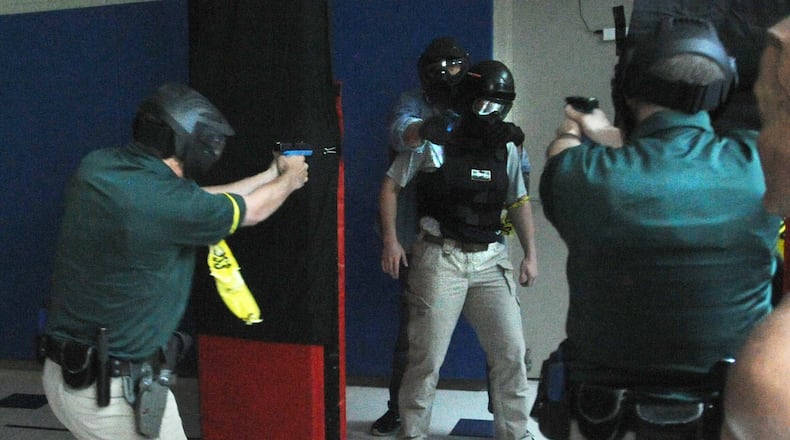During the final week of Sinclair Police Academy classes, the academy instructors and top brass turn gymnasium mats into apartment walls, arm themselves with paintball guns and helmets, turn off the lights, and fill the first floor of Sinclair’s Building 19 with the cacophony that is Metallica’s Enter Sandman (and later, the theme from the Good, the Bad and the Ugly).
This is where the cadets’ training comes together.
Academy Commander Joe Niehaus, having traded his usual uniform for a wilted t-shirt, jean jacket, helmet and a paintball vest, waits at the end of a maze of gym mat walls. What the cadets don’t know, as they enter the “apartment” two at a time, is that they will be confronted with Niehaus pointing his gun at the head of a female victim, in a mock domestic dispute.
Cadet Cameron Johnson and this reporter were “dispatched” to the gymnasium of Building 19 around 10:15 a.m. We entered the residence and spoke to the person who called 911, and asked if there were any weapons in the house.
Johnson heard a single gunshot and went on ahead. I stayed to talk to two other people who had entered the room from the left, one of whom was “recording” on his phone. Just as I was asking them to turn down the music, in order to remove the distraction and make it easier to talk, I heard shouting from further in the “apartment.”
Dashing down the hall, I turned the corner to see Johnson in a standoff with who I later learned was Niehaus, Johnson’s gun drawn and pointed at him, the suspect’s gun to the temple of a hostage.
Commands of “drop the gun” were bellowed across the gap in the doorway on both sides. At the last second, the suspect pushed his hostage away and fired on us.
Another thing we didn’t know at the time, the guns we had been handed only had a single shot in the magazine. Were this real life, both of us would probably be dead.
At the close of the scenario, everyone took off their helmets to debrief. All of us were covered in gobs of bright pink paint. One of Niehaus’ bullets had torn a hole through the sleeve of Johnson’s jacket.
With calmer heads, there were several things we could have done: opening up a line of communication and trying to talk down the suspect, sticking together, and perhaps most notably, not standing smack in the middle of the doorway when facing the person with the gun.
Not a single person’s response to this scenario went off without a hitch.
“I think it provides valuable training in the sense that you don’t always have to go in hot and heavy to every single call,” said cadet Patrick Wollum, who did the above scenario with cadet Chris Jones. “And that’s exactly what I did once I heard the gunshot. I left Jones. I think even if you do hear gunshots, you need to get there a little faster, but you still need to be methodical in the way you attack it. You don’t just throw everything out the window.”
Later, this reporter stepped in from the actor’s point of view, serving as Niehaus’ hostage.
After the debriefing, this reporter remarked to Niehaus her frustration of knowing what she should have done and would do given a second chance.
“Apply that to what these guys and gals do on the road. They don’t get a second chance,” he said.
Combined scenarios in the academy is only the beginning. In the six months to a year following the academy, cadets work with more experienced officers to train the mind to handle situations just like this.
“The first day on the job, you’re going to feel like you don’t remember anything,” said Officer Ezra Haponek. Haponek graduated with the previous class of the Sinclair Police Academy, and volunteered to be an actor in combined scenarios training.
The other three scenarios included pulling over a woman suspected of driving under the influence and performing a field sobriety test, investigating two individuals entering a “business” after hours (this reporter got shot in this one too), and helping a deaf woman who called 911 to report a single-vehicle crash.
In the future, scenarios such as these may be supplanted — or enhanced by — virtual reality. Rather than paintball, or pieces of paper describing crash damage, cadets in the future may use VR goggles to be transported to the scene of a crime.
Combined scenarios training is not required by state standards for law enforcement training, but it has been praised by cadets as one of the most impactful parts of their training, Niehaus said.
“It was overall pretty good training,” Wollum said. “It makes you think. It heightens your stress. So that way, when you do get in that stressful situation, you can kind of fall back like okay, I’ve had something similar to this.”
About the Author




